Leadership and Enterprise: Comparing Leadership Approaches and Results
VerifiedAdded on 2022/12/01
|16
|2587
|369
Report
AI Summary
This report analyzes leadership and enterprise management through a case study of Sunshine Snack, comparing the leadership styles of two managers, Ben Samuels and Phil Jones. The report examines their approaches to employee relations, motivation, and decision-making, highlighting the differences in employee retention rates, production costs, and overall team performance. Section A delves into leadership traits, comparing the dedication, style, and motivation factors of both managers. Section B explores Tuckman's stages of team development, outlining the five stages a team goes through, and contrasts leadership and management, defining their roles, skills, and strategies. The analysis provides insights into effective leadership practices and their impact on organizational outcomes.
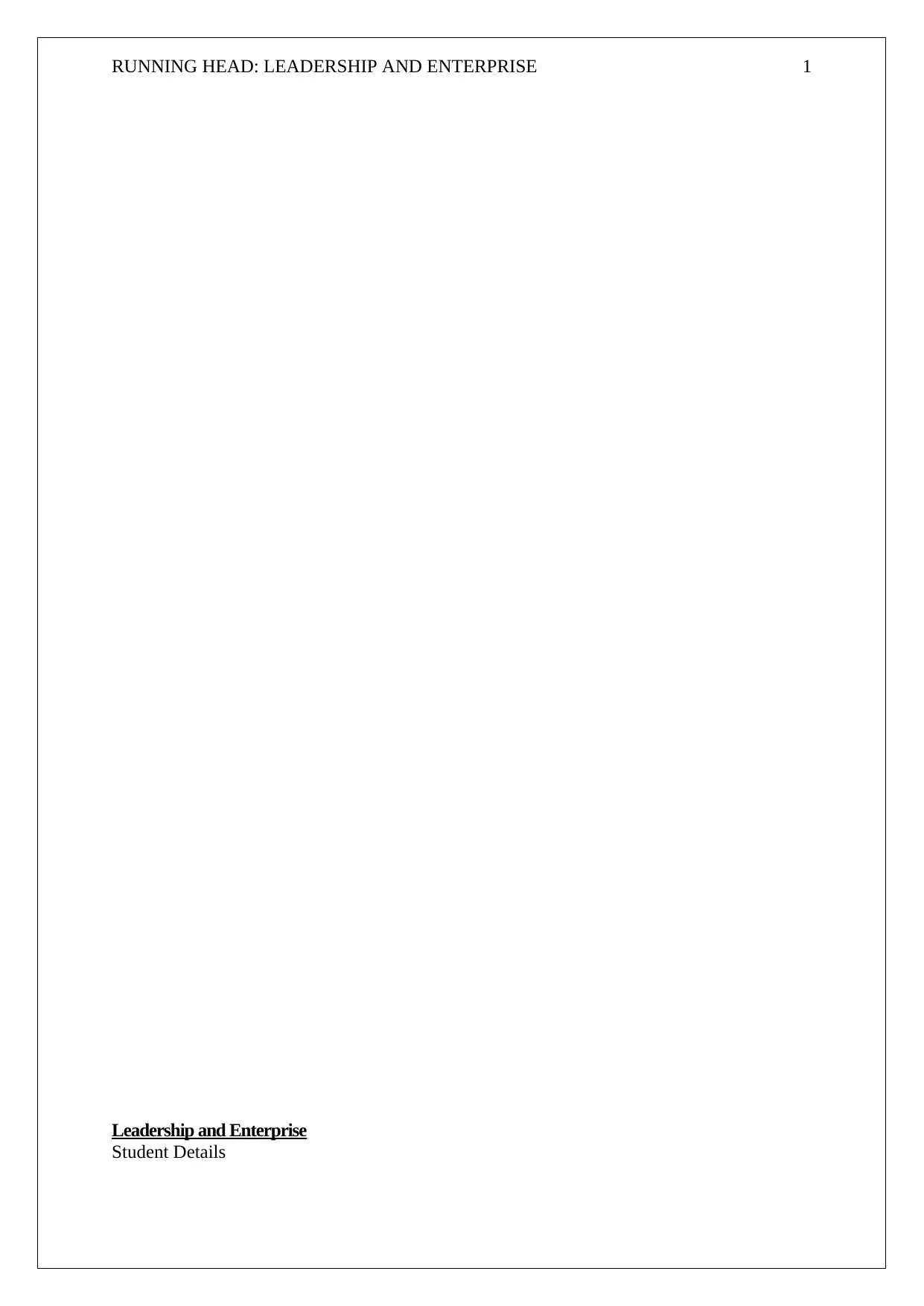
RUNNING HEAD: LEADERSHIP AND ENTERPRISE 1
Leadership and Enterprise
Student Details
Leadership and Enterprise
Student Details
Paraphrase This Document
Need a fresh take? Get an instant paraphrase of this document with our AI Paraphraser
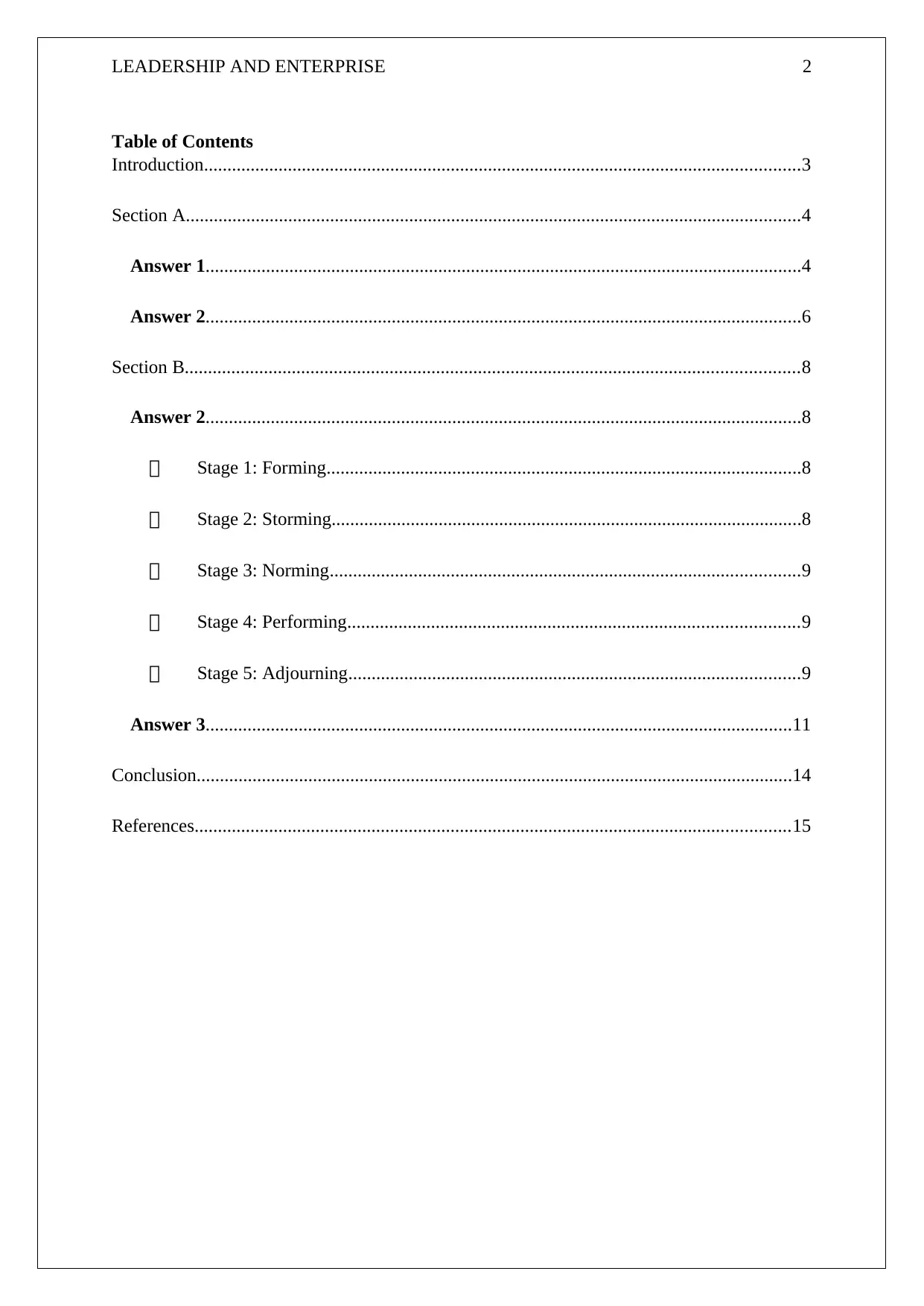
LEADERSHIP AND ENTERPRISE 2
Table of Contents
Introduction................................................................................................................................3
Section A....................................................................................................................................4
Answer 1................................................................................................................................4
Answer 2................................................................................................................................6
Section B....................................................................................................................................8
Answer 2................................................................................................................................8
Stage 1: Forming......................................................................................................8
Stage 2: Storming.....................................................................................................8
Stage 3: Norming.....................................................................................................9
Stage 4: Performing.................................................................................................9
Stage 5: Adjourning.................................................................................................9
Answer 3..............................................................................................................................11
Conclusion................................................................................................................................14
References................................................................................................................................15
Table of Contents
Introduction................................................................................................................................3
Section A....................................................................................................................................4
Answer 1................................................................................................................................4
Answer 2................................................................................................................................6
Section B....................................................................................................................................8
Answer 2................................................................................................................................8
Stage 1: Forming......................................................................................................8
Stage 2: Storming.....................................................................................................8
Stage 3: Norming.....................................................................................................9
Stage 4: Performing.................................................................................................9
Stage 5: Adjourning.................................................................................................9
Answer 3..............................................................................................................................11
Conclusion................................................................................................................................14
References................................................................................................................................15
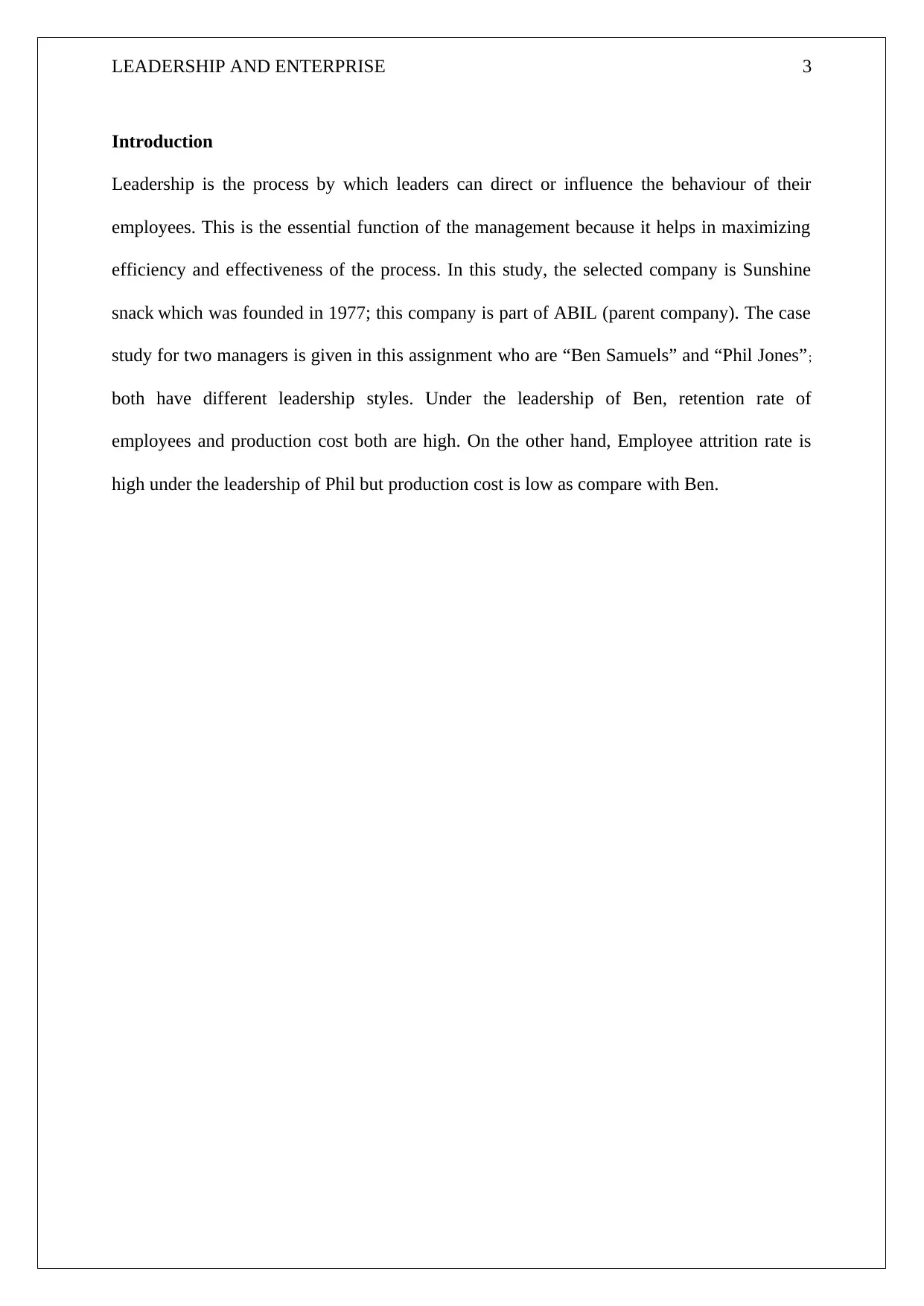
LEADERSHIP AND ENTERPRISE 3
Introduction
Leadership is the process by which leaders can direct or influence the behaviour of their
employees. This is the essential function of the management because it helps in maximizing
efficiency and effectiveness of the process. In this study, the selected company is Sunshine
snack which was founded in 1977; this company is part of ABIL (parent company). The case
study for two managers is given in this assignment who are “Ben Samuels” and “Phil Jones”;
both have different leadership styles. Under the leadership of Ben, retention rate of
employees and production cost both are high. On the other hand, Employee attrition rate is
high under the leadership of Phil but production cost is low as compare with Ben.
Introduction
Leadership is the process by which leaders can direct or influence the behaviour of their
employees. This is the essential function of the management because it helps in maximizing
efficiency and effectiveness of the process. In this study, the selected company is Sunshine
snack which was founded in 1977; this company is part of ABIL (parent company). The case
study for two managers is given in this assignment who are “Ben Samuels” and “Phil Jones”;
both have different leadership styles. Under the leadership of Ben, retention rate of
employees and production cost both are high. On the other hand, Employee attrition rate is
high under the leadership of Phil but production cost is low as compare with Ben.
⊘ This is a preview!⊘
Do you want full access?
Subscribe today to unlock all pages.

Trusted by 1+ million students worldwide
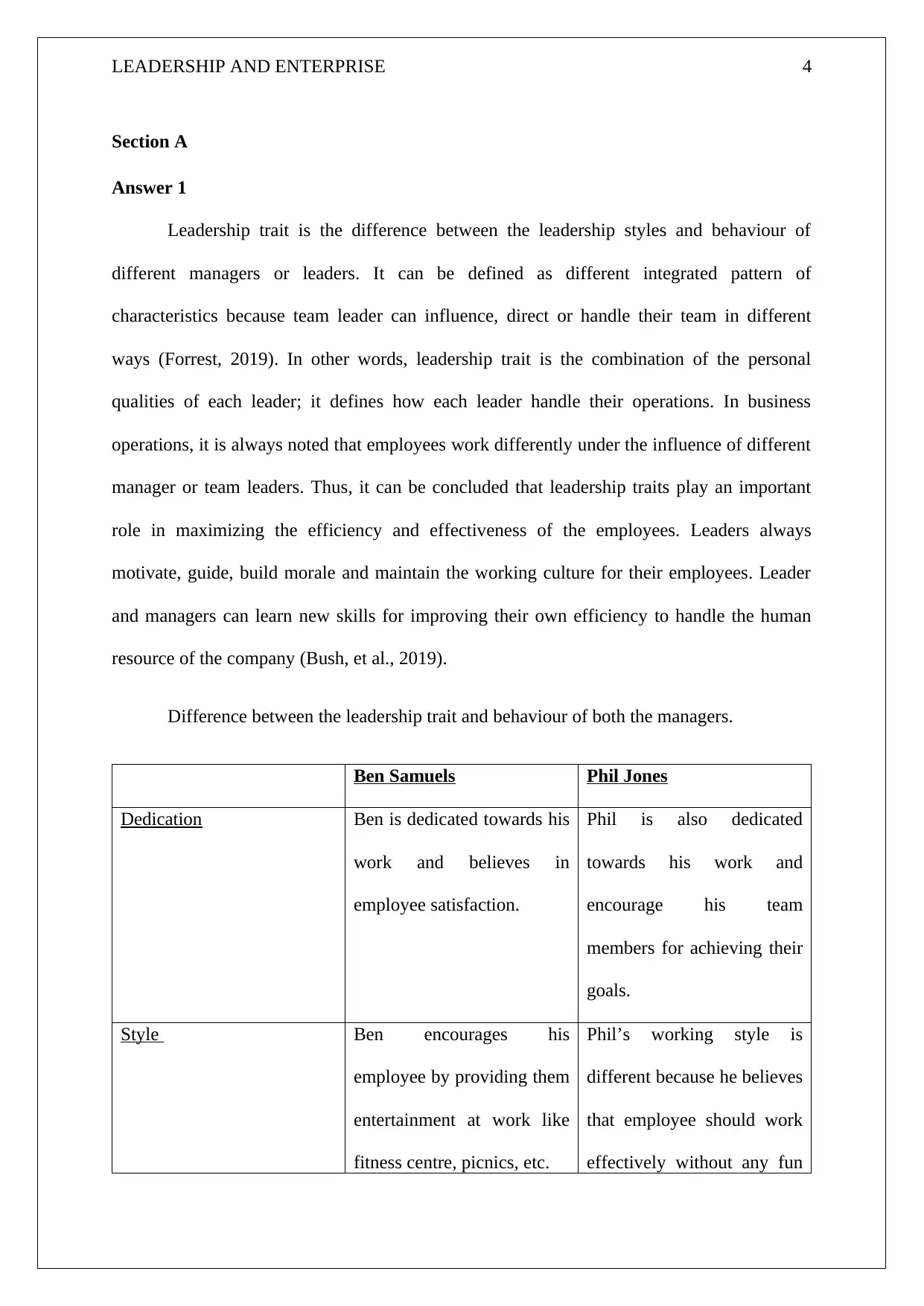
LEADERSHIP AND ENTERPRISE 4
Section A
Answer 1
Leadership trait is the difference between the leadership styles and behaviour of
different managers or leaders. It can be defined as different integrated pattern of
characteristics because team leader can influence, direct or handle their team in different
ways (Forrest, 2019). In other words, leadership trait is the combination of the personal
qualities of each leader; it defines how each leader handle their operations. In business
operations, it is always noted that employees work differently under the influence of different
manager or team leaders. Thus, it can be concluded that leadership traits play an important
role in maximizing the efficiency and effectiveness of the employees. Leaders always
motivate, guide, build morale and maintain the working culture for their employees. Leader
and managers can learn new skills for improving their own efficiency to handle the human
resource of the company (Bush, et al., 2019).
Difference between the leadership trait and behaviour of both the managers.
Ben Samuels Phil Jones
Dedication Ben is dedicated towards his
work and believes in
employee satisfaction.
Phil is also dedicated
towards his work and
encourage his team
members for achieving their
goals.
Style Ben encourages his
employee by providing them
entertainment at work like
fitness centre, picnics, etc.
Phil’s working style is
different because he believes
that employee should work
effectively without any fun
Section A
Answer 1
Leadership trait is the difference between the leadership styles and behaviour of
different managers or leaders. It can be defined as different integrated pattern of
characteristics because team leader can influence, direct or handle their team in different
ways (Forrest, 2019). In other words, leadership trait is the combination of the personal
qualities of each leader; it defines how each leader handle their operations. In business
operations, it is always noted that employees work differently under the influence of different
manager or team leaders. Thus, it can be concluded that leadership traits play an important
role in maximizing the efficiency and effectiveness of the employees. Leaders always
motivate, guide, build morale and maintain the working culture for their employees. Leader
and managers can learn new skills for improving their own efficiency to handle the human
resource of the company (Bush, et al., 2019).
Difference between the leadership trait and behaviour of both the managers.
Ben Samuels Phil Jones
Dedication Ben is dedicated towards his
work and believes in
employee satisfaction.
Phil is also dedicated
towards his work and
encourage his team
members for achieving their
goals.
Style Ben encourages his
employee by providing them
entertainment at work like
fitness centre, picnics, etc.
Phil’s working style is
different because he believes
that employee should work
effectively without any fun
Paraphrase This Document
Need a fresh take? Get an instant paraphrase of this document with our AI Paraphraser
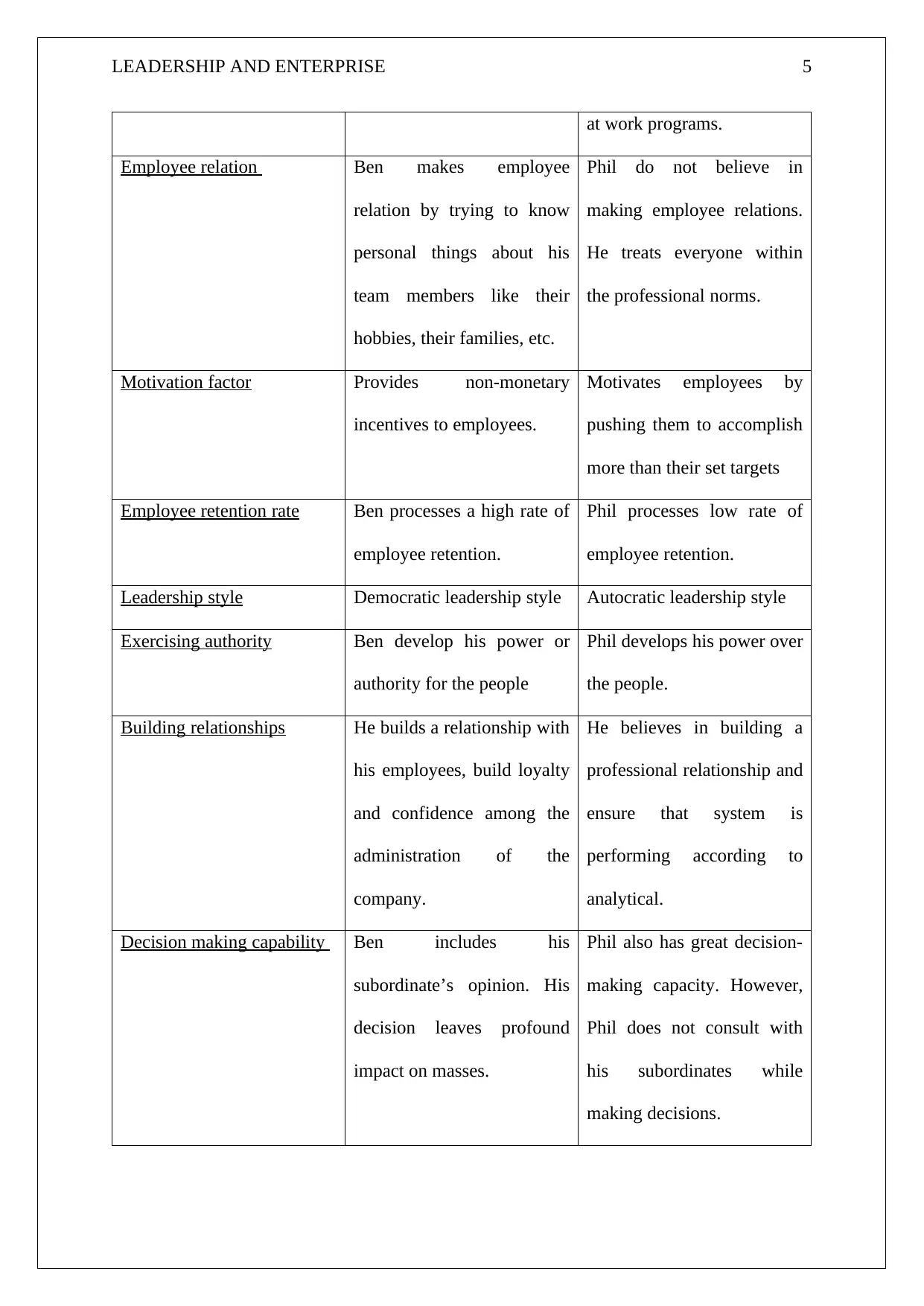
LEADERSHIP AND ENTERPRISE 5
at work programs.
Employee relation Ben makes employee
relation by trying to know
personal things about his
team members like their
hobbies, their families, etc.
Phil do not believe in
making employee relations.
He treats everyone within
the professional norms.
Motivation factor Provides non-monetary
incentives to employees.
Motivates employees by
pushing them to accomplish
more than their set targets
Employee retention rate Ben processes a high rate of
employee retention.
Phil processes low rate of
employee retention.
Leadership style Democratic leadership style Autocratic leadership style
Exercising authority Ben develop his power or
authority for the people
Phil develops his power over
the people.
Building relationships He builds a relationship with
his employees, build loyalty
and confidence among the
administration of the
company.
He believes in building a
professional relationship and
ensure that system is
performing according to
analytical.
Decision making capability Ben includes his
subordinate’s opinion. His
decision leaves profound
impact on masses.
Phil also has great decision-
making capacity. However,
Phil does not consult with
his subordinates while
making decisions.
at work programs.
Employee relation Ben makes employee
relation by trying to know
personal things about his
team members like their
hobbies, their families, etc.
Phil do not believe in
making employee relations.
He treats everyone within
the professional norms.
Motivation factor Provides non-monetary
incentives to employees.
Motivates employees by
pushing them to accomplish
more than their set targets
Employee retention rate Ben processes a high rate of
employee retention.
Phil processes low rate of
employee retention.
Leadership style Democratic leadership style Autocratic leadership style
Exercising authority Ben develop his power or
authority for the people
Phil develops his power over
the people.
Building relationships He builds a relationship with
his employees, build loyalty
and confidence among the
administration of the
company.
He believes in building a
professional relationship and
ensure that system is
performing according to
analytical.
Decision making capability Ben includes his
subordinate’s opinion. His
decision leaves profound
impact on masses.
Phil also has great decision-
making capacity. However,
Phil does not consult with
his subordinates while
making decisions.
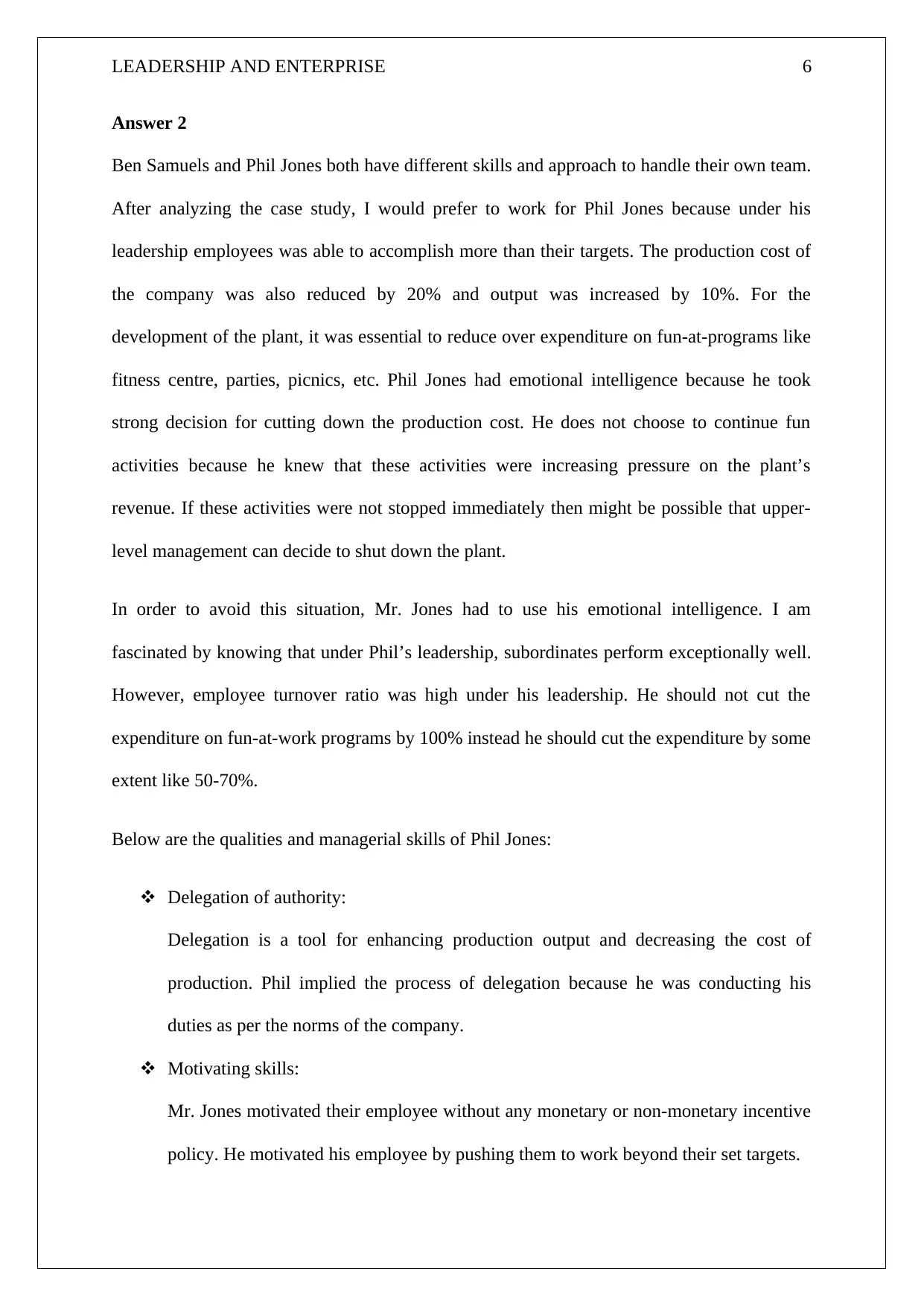
LEADERSHIP AND ENTERPRISE 6
Answer 2
Ben Samuels and Phil Jones both have different skills and approach to handle their own team.
After analyzing the case study, I would prefer to work for Phil Jones because under his
leadership employees was able to accomplish more than their targets. The production cost of
the company was also reduced by 20% and output was increased by 10%. For the
development of the plant, it was essential to reduce over expenditure on fun-at-programs like
fitness centre, parties, picnics, etc. Phil Jones had emotional intelligence because he took
strong decision for cutting down the production cost. He does not choose to continue fun
activities because he knew that these activities were increasing pressure on the plant’s
revenue. If these activities were not stopped immediately then might be possible that upper-
level management can decide to shut down the plant.
In order to avoid this situation, Mr. Jones had to use his emotional intelligence. I am
fascinated by knowing that under Phil’s leadership, subordinates perform exceptionally well.
However, employee turnover ratio was high under his leadership. He should not cut the
expenditure on fun-at-work programs by 100% instead he should cut the expenditure by some
extent like 50-70%.
Below are the qualities and managerial skills of Phil Jones:
Delegation of authority:
Delegation is a tool for enhancing production output and decreasing the cost of
production. Phil implied the process of delegation because he was conducting his
duties as per the norms of the company.
Motivating skills:
Mr. Jones motivated their employee without any monetary or non-monetary incentive
policy. He motivated his employee by pushing them to work beyond their set targets.
Answer 2
Ben Samuels and Phil Jones both have different skills and approach to handle their own team.
After analyzing the case study, I would prefer to work for Phil Jones because under his
leadership employees was able to accomplish more than their targets. The production cost of
the company was also reduced by 20% and output was increased by 10%. For the
development of the plant, it was essential to reduce over expenditure on fun-at-programs like
fitness centre, parties, picnics, etc. Phil Jones had emotional intelligence because he took
strong decision for cutting down the production cost. He does not choose to continue fun
activities because he knew that these activities were increasing pressure on the plant’s
revenue. If these activities were not stopped immediately then might be possible that upper-
level management can decide to shut down the plant.
In order to avoid this situation, Mr. Jones had to use his emotional intelligence. I am
fascinated by knowing that under Phil’s leadership, subordinates perform exceptionally well.
However, employee turnover ratio was high under his leadership. He should not cut the
expenditure on fun-at-work programs by 100% instead he should cut the expenditure by some
extent like 50-70%.
Below are the qualities and managerial skills of Phil Jones:
Delegation of authority:
Delegation is a tool for enhancing production output and decreasing the cost of
production. Phil implied the process of delegation because he was conducting his
duties as per the norms of the company.
Motivating skills:
Mr. Jones motivated their employee without any monetary or non-monetary incentive
policy. He motivated his employee by pushing them to work beyond their set targets.
⊘ This is a preview!⊘
Do you want full access?
Subscribe today to unlock all pages.

Trusted by 1+ million students worldwide
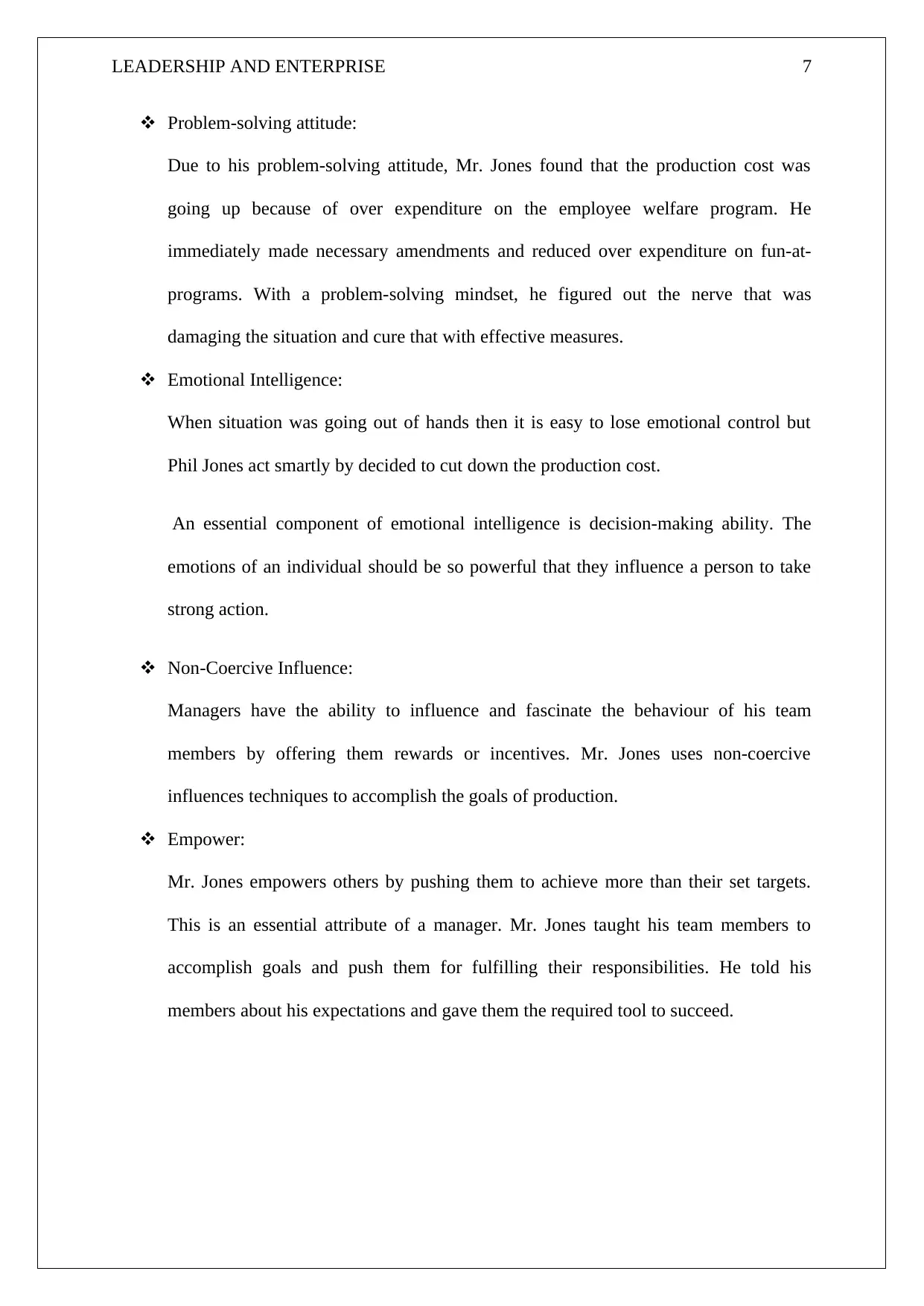
LEADERSHIP AND ENTERPRISE 7
Problem-solving attitude:
Due to his problem-solving attitude, Mr. Jones found that the production cost was
going up because of over expenditure on the employee welfare program. He
immediately made necessary amendments and reduced over expenditure on fun-at-
programs. With a problem-solving mindset, he figured out the nerve that was
damaging the situation and cure that with effective measures.
Emotional Intelligence:
When situation was going out of hands then it is easy to lose emotional control but
Phil Jones act smartly by decided to cut down the production cost.
An essential component of emotional intelligence is decision-making ability. The
emotions of an individual should be so powerful that they influence a person to take
strong action.
Non-Coercive Influence:
Managers have the ability to influence and fascinate the behaviour of his team
members by offering them rewards or incentives. Mr. Jones uses non-coercive
influences techniques to accomplish the goals of production.
Empower:
Mr. Jones empowers others by pushing them to achieve more than their set targets.
This is an essential attribute of a manager. Mr. Jones taught his team members to
accomplish goals and push them for fulfilling their responsibilities. He told his
members about his expectations and gave them the required tool to succeed.
Problem-solving attitude:
Due to his problem-solving attitude, Mr. Jones found that the production cost was
going up because of over expenditure on the employee welfare program. He
immediately made necessary amendments and reduced over expenditure on fun-at-
programs. With a problem-solving mindset, he figured out the nerve that was
damaging the situation and cure that with effective measures.
Emotional Intelligence:
When situation was going out of hands then it is easy to lose emotional control but
Phil Jones act smartly by decided to cut down the production cost.
An essential component of emotional intelligence is decision-making ability. The
emotions of an individual should be so powerful that they influence a person to take
strong action.
Non-Coercive Influence:
Managers have the ability to influence and fascinate the behaviour of his team
members by offering them rewards or incentives. Mr. Jones uses non-coercive
influences techniques to accomplish the goals of production.
Empower:
Mr. Jones empowers others by pushing them to achieve more than their set targets.
This is an essential attribute of a manager. Mr. Jones taught his team members to
accomplish goals and push them for fulfilling their responsibilities. He told his
members about his expectations and gave them the required tool to succeed.
Paraphrase This Document
Need a fresh take? Get an instant paraphrase of this document with our AI Paraphraser
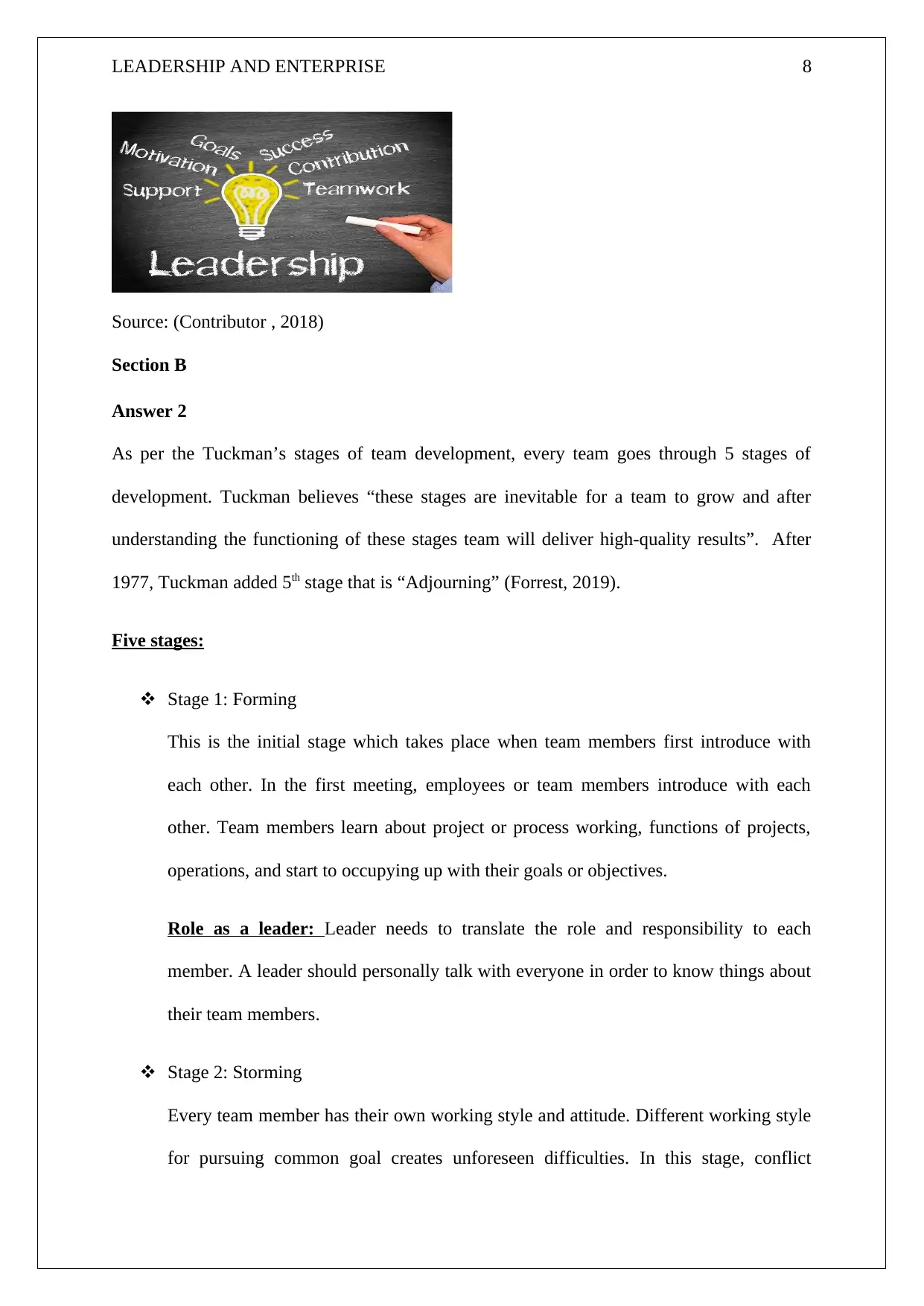
LEADERSHIP AND ENTERPRISE 8
Source: (Contributor , 2018)
Section B
Answer 2
As per the Tuckman’s stages of team development, every team goes through 5 stages of
development. Tuckman believes “these stages are inevitable for a team to grow and after
understanding the functioning of these stages team will deliver high-quality results”. After
1977, Tuckman added 5th stage that is “Adjourning” (Forrest, 2019).
Five stages:
Stage 1: Forming
This is the initial stage which takes place when team members first introduce with
each other. In the first meeting, employees or team members introduce with each
other. Team members learn about project or process working, functions of projects,
operations, and start to occupying up with their goals or objectives.
Role as a leader: Leader needs to translate the role and responsibility to each
member. A leader should personally talk with everyone in order to know things about
their team members.
Stage 2: Storming
Every team member has their own working style and attitude. Different working style
for pursuing common goal creates unforeseen difficulties. In this stage, conflict
Source: (Contributor , 2018)
Section B
Answer 2
As per the Tuckman’s stages of team development, every team goes through 5 stages of
development. Tuckman believes “these stages are inevitable for a team to grow and after
understanding the functioning of these stages team will deliver high-quality results”. After
1977, Tuckman added 5th stage that is “Adjourning” (Forrest, 2019).
Five stages:
Stage 1: Forming
This is the initial stage which takes place when team members first introduce with
each other. In the first meeting, employees or team members introduce with each
other. Team members learn about project or process working, functions of projects,
operations, and start to occupying up with their goals or objectives.
Role as a leader: Leader needs to translate the role and responsibility to each
member. A leader should personally talk with everyone in order to know things about
their team members.
Stage 2: Storming
Every team member has their own working style and attitude. Different working style
for pursuing common goal creates unforeseen difficulties. In this stage, conflict
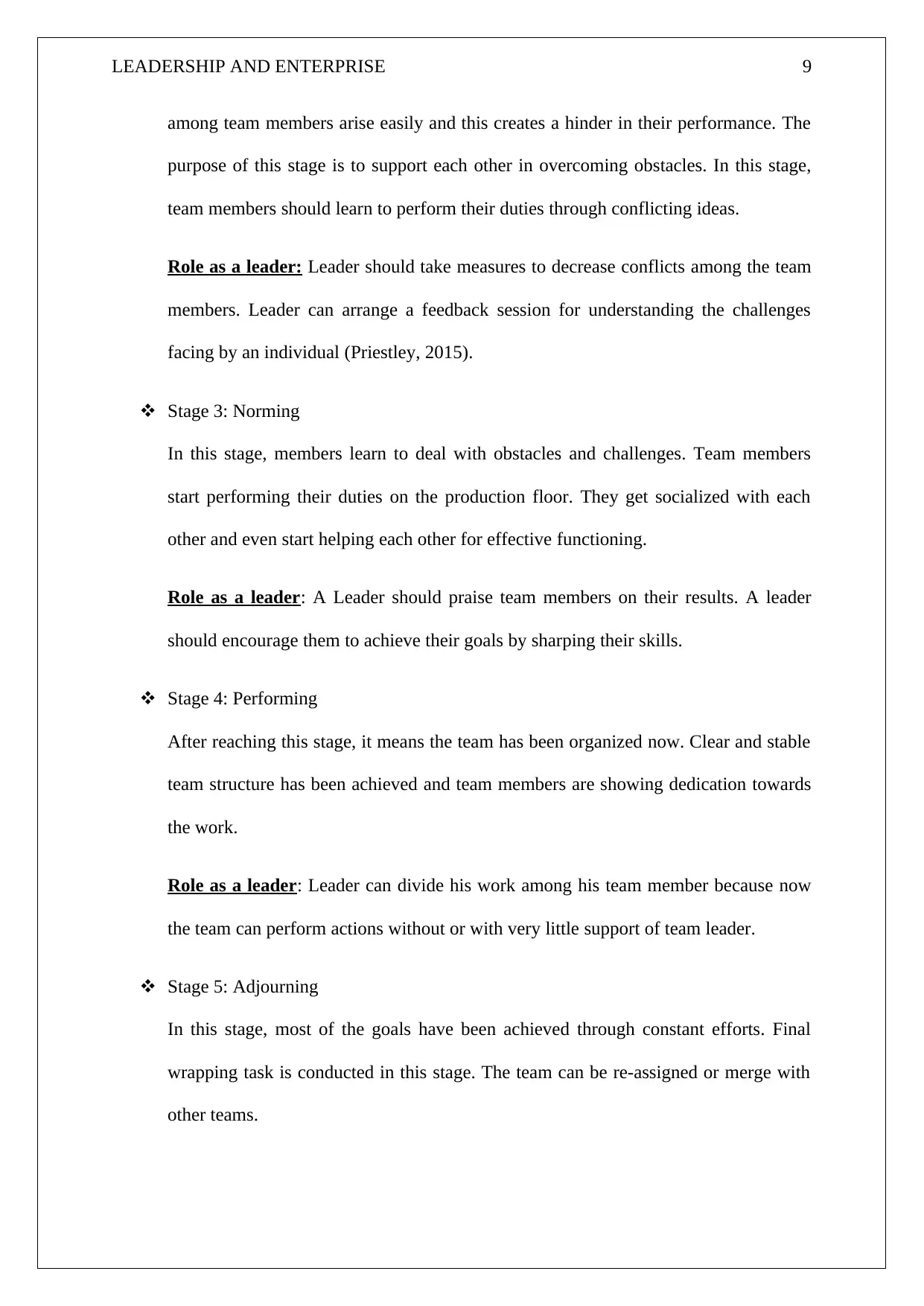
LEADERSHIP AND ENTERPRISE 9
among team members arise easily and this creates a hinder in their performance. The
purpose of this stage is to support each other in overcoming obstacles. In this stage,
team members should learn to perform their duties through conflicting ideas.
Role as a leader: Leader should take measures to decrease conflicts among the team
members. Leader can arrange a feedback session for understanding the challenges
facing by an individual (Priestley, 2015).
Stage 3: Norming
In this stage, members learn to deal with obstacles and challenges. Team members
start performing their duties on the production floor. They get socialized with each
other and even start helping each other for effective functioning.
Role as a leader: A Leader should praise team members on their results. A leader
should encourage them to achieve their goals by sharping their skills.
Stage 4: Performing
After reaching this stage, it means the team has been organized now. Clear and stable
team structure has been achieved and team members are showing dedication towards
the work.
Role as a leader: Leader can divide his work among his team member because now
the team can perform actions without or with very little support of team leader.
Stage 5: Adjourning
In this stage, most of the goals have been achieved through constant efforts. Final
wrapping task is conducted in this stage. The team can be re-assigned or merge with
other teams.
among team members arise easily and this creates a hinder in their performance. The
purpose of this stage is to support each other in overcoming obstacles. In this stage,
team members should learn to perform their duties through conflicting ideas.
Role as a leader: Leader should take measures to decrease conflicts among the team
members. Leader can arrange a feedback session for understanding the challenges
facing by an individual (Priestley, 2015).
Stage 3: Norming
In this stage, members learn to deal with obstacles and challenges. Team members
start performing their duties on the production floor. They get socialized with each
other and even start helping each other for effective functioning.
Role as a leader: A Leader should praise team members on their results. A leader
should encourage them to achieve their goals by sharping their skills.
Stage 4: Performing
After reaching this stage, it means the team has been organized now. Clear and stable
team structure has been achieved and team members are showing dedication towards
the work.
Role as a leader: Leader can divide his work among his team member because now
the team can perform actions without or with very little support of team leader.
Stage 5: Adjourning
In this stage, most of the goals have been achieved through constant efforts. Final
wrapping task is conducted in this stage. The team can be re-assigned or merge with
other teams.
⊘ This is a preview!⊘
Do you want full access?
Subscribe today to unlock all pages.

Trusted by 1+ million students worldwide
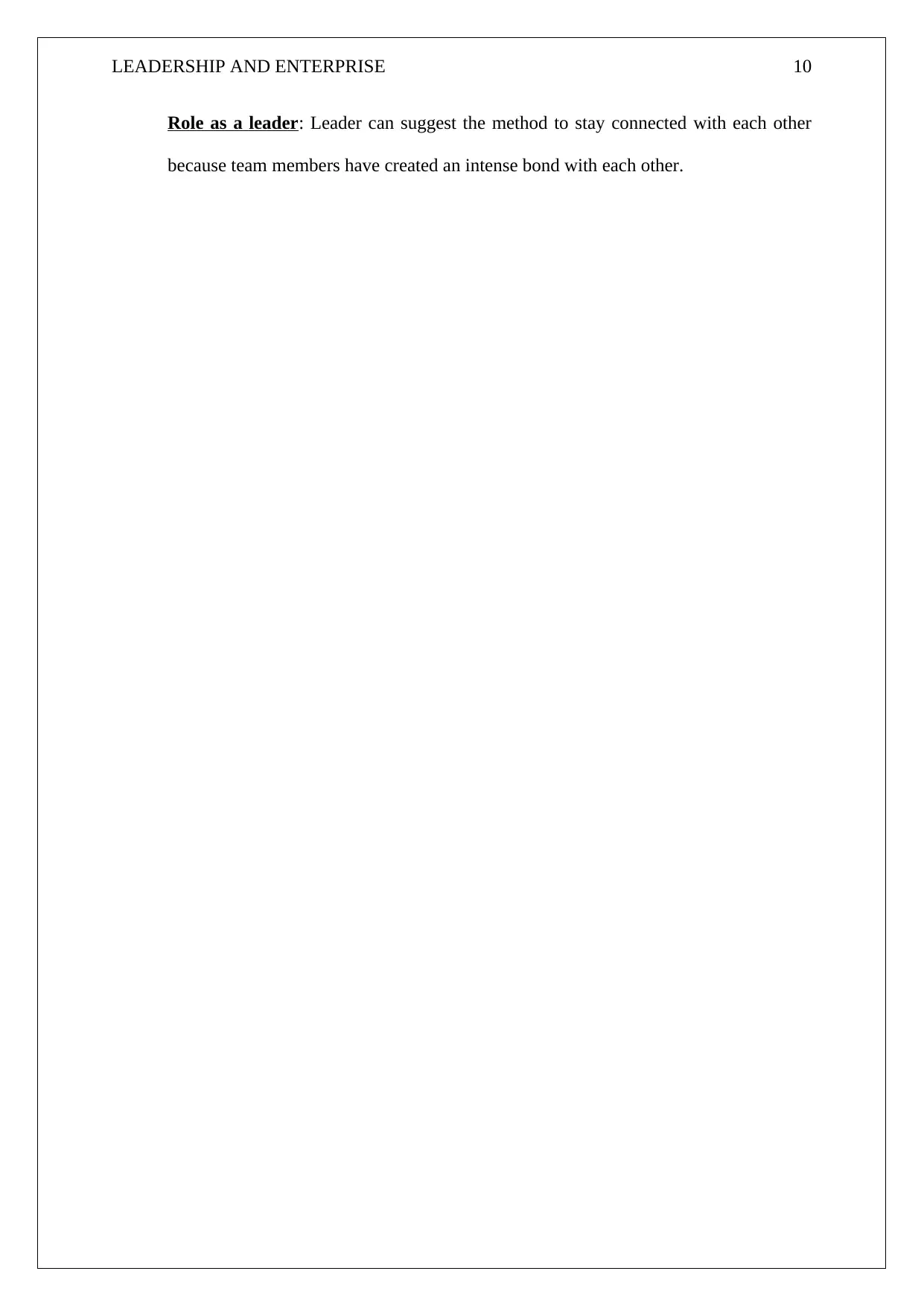
LEADERSHIP AND ENTERPRISE 10
Role as a leader: Leader can suggest the method to stay connected with each other
because team members have created an intense bond with each other.
Role as a leader: Leader can suggest the method to stay connected with each other
because team members have created an intense bond with each other.
Paraphrase This Document
Need a fresh take? Get an instant paraphrase of this document with our AI Paraphraser
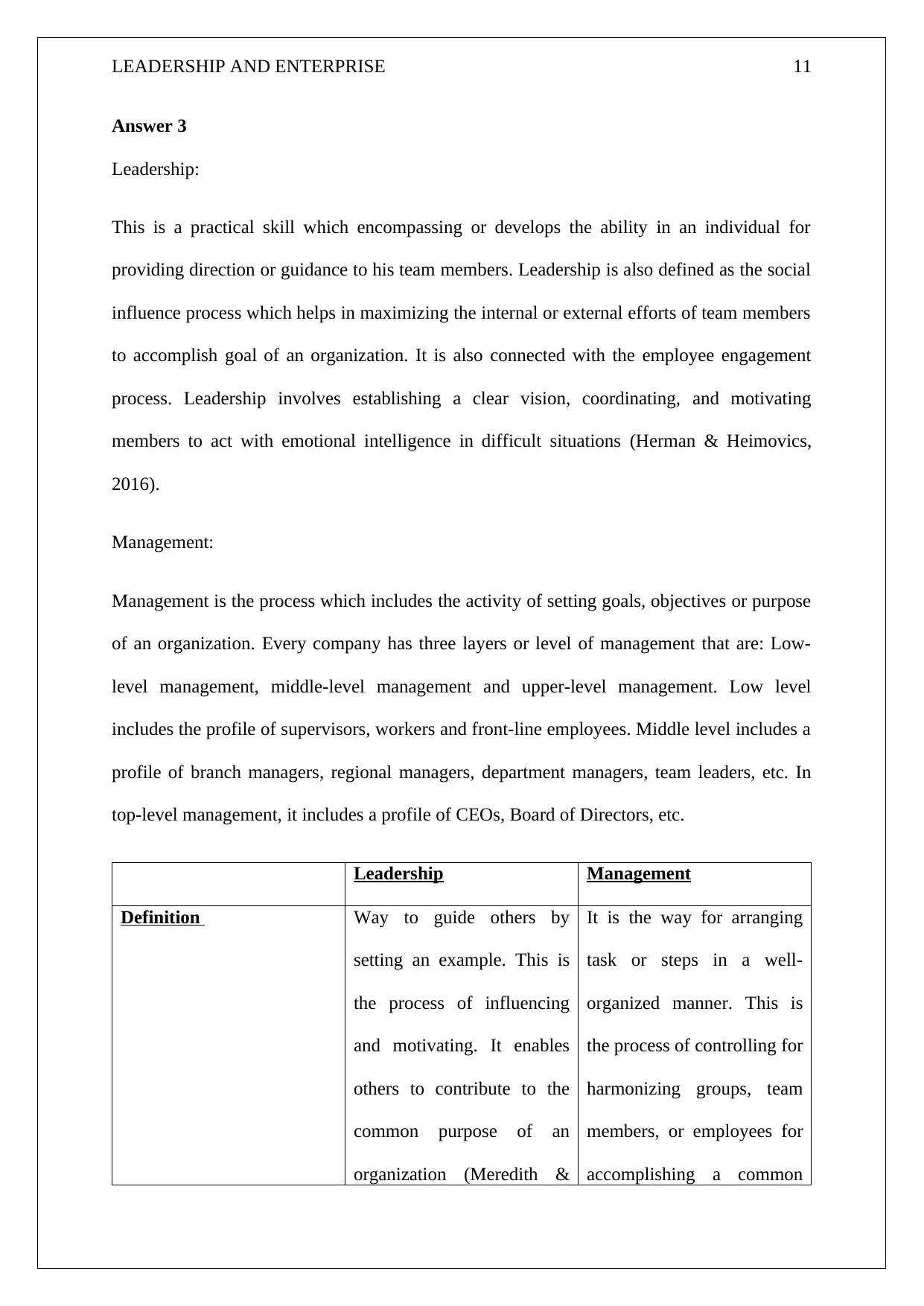
LEADERSHIP AND ENTERPRISE 11
Answer 3
Leadership:
This is a practical skill which encompassing or develops the ability in an individual for
providing direction or guidance to his team members. Leadership is also defined as the social
influence process which helps in maximizing the internal or external efforts of team members
to accomplish goal of an organization. It is also connected with the employee engagement
process. Leadership involves establishing a clear vision, coordinating, and motivating
members to act with emotional intelligence in difficult situations (Herman & Heimovics,
2016).
Management:
Management is the process which includes the activity of setting goals, objectives or purpose
of an organization. Every company has three layers or level of management that are: Low-
level management, middle-level management and upper-level management. Low level
includes the profile of supervisors, workers and front-line employees. Middle level includes a
profile of branch managers, regional managers, department managers, team leaders, etc. In
top-level management, it includes a profile of CEOs, Board of Directors, etc.
Leadership Management
Definition Way to guide others by
setting an example. This is
the process of influencing
and motivating. It enables
others to contribute to the
common purpose of an
organization (Meredith &
It is the way for arranging
task or steps in a well-
organized manner. This is
the process of controlling for
harmonizing groups, team
members, or employees for
accomplishing a common
Answer 3
Leadership:
This is a practical skill which encompassing or develops the ability in an individual for
providing direction or guidance to his team members. Leadership is also defined as the social
influence process which helps in maximizing the internal or external efforts of team members
to accomplish goal of an organization. It is also connected with the employee engagement
process. Leadership involves establishing a clear vision, coordinating, and motivating
members to act with emotional intelligence in difficult situations (Herman & Heimovics,
2016).
Management:
Management is the process which includes the activity of setting goals, objectives or purpose
of an organization. Every company has three layers or level of management that are: Low-
level management, middle-level management and upper-level management. Low level
includes the profile of supervisors, workers and front-line employees. Middle level includes a
profile of branch managers, regional managers, department managers, team leaders, etc. In
top-level management, it includes a profile of CEOs, Board of Directors, etc.
Leadership Management
Definition Way to guide others by
setting an example. This is
the process of influencing
and motivating. It enables
others to contribute to the
common purpose of an
organization (Meredith &
It is the way for arranging
task or steps in a well-
organized manner. This is
the process of controlling for
harmonizing groups, team
members, or employees for
accomplishing a common
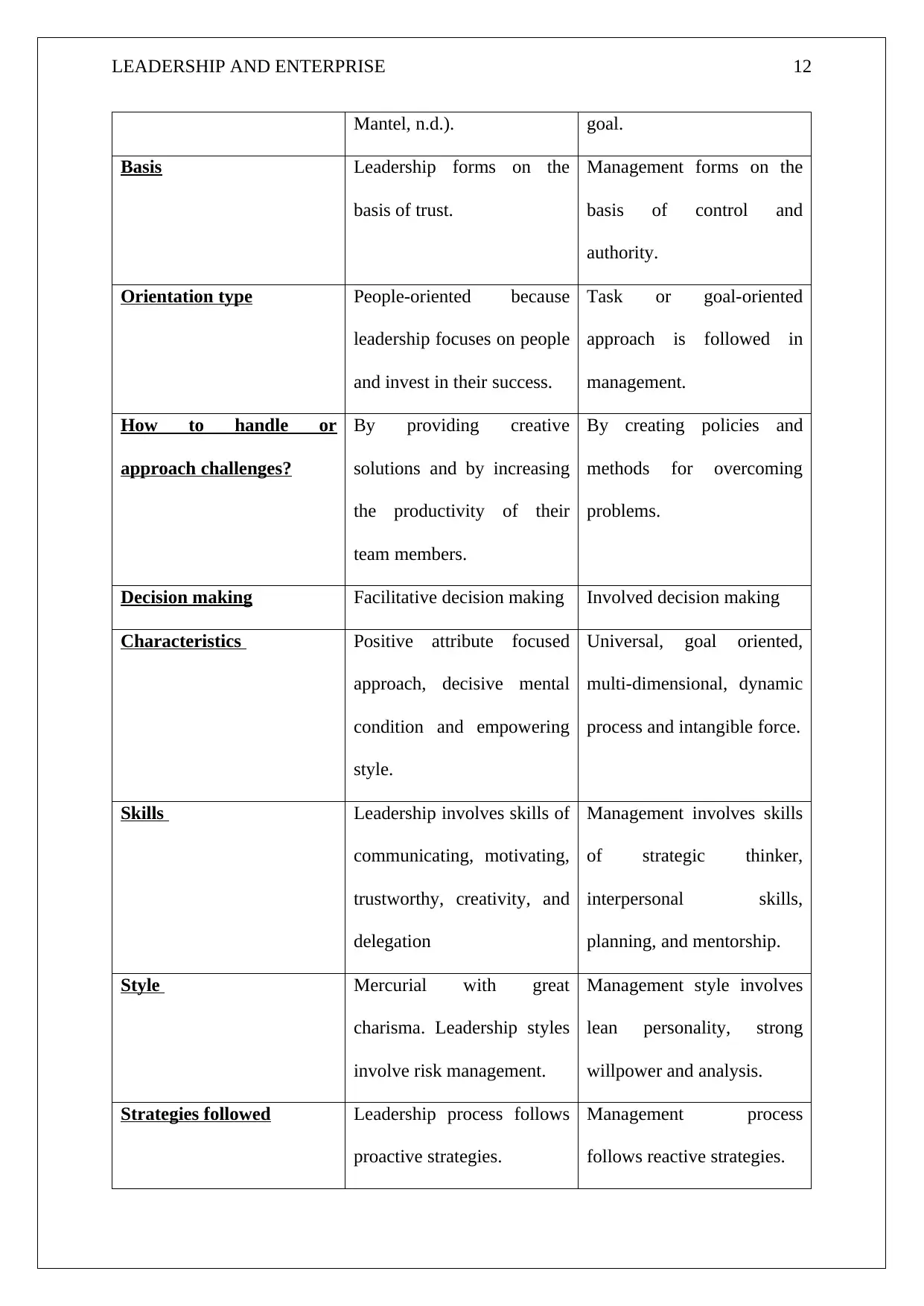
LEADERSHIP AND ENTERPRISE 12
Mantel, n.d.). goal.
Basis Leadership forms on the
basis of trust.
Management forms on the
basis of control and
authority.
Orientation type People-oriented because
leadership focuses on people
and invest in their success.
Task or goal-oriented
approach is followed in
management.
How to handle or
approach challenges?
By providing creative
solutions and by increasing
the productivity of their
team members.
By creating policies and
methods for overcoming
problems.
Decision making Facilitative decision making Involved decision making
Characteristics Positive attribute focused
approach, decisive mental
condition and empowering
style.
Universal, goal oriented,
multi-dimensional, dynamic
process and intangible force.
Skills Leadership involves skills of
communicating, motivating,
trustworthy, creativity, and
delegation
Management involves skills
of strategic thinker,
interpersonal skills,
planning, and mentorship.
Style Mercurial with great
charisma. Leadership styles
involve risk management.
Management style involves
lean personality, strong
willpower and analysis.
Strategies followed Leadership process follows
proactive strategies.
Management process
follows reactive strategies.
Mantel, n.d.). goal.
Basis Leadership forms on the
basis of trust.
Management forms on the
basis of control and
authority.
Orientation type People-oriented because
leadership focuses on people
and invest in their success.
Task or goal-oriented
approach is followed in
management.
How to handle or
approach challenges?
By providing creative
solutions and by increasing
the productivity of their
team members.
By creating policies and
methods for overcoming
problems.
Decision making Facilitative decision making Involved decision making
Characteristics Positive attribute focused
approach, decisive mental
condition and empowering
style.
Universal, goal oriented,
multi-dimensional, dynamic
process and intangible force.
Skills Leadership involves skills of
communicating, motivating,
trustworthy, creativity, and
delegation
Management involves skills
of strategic thinker,
interpersonal skills,
planning, and mentorship.
Style Mercurial with great
charisma. Leadership styles
involve risk management.
Management style involves
lean personality, strong
willpower and analysis.
Strategies followed Leadership process follows
proactive strategies.
Management process
follows reactive strategies.
⊘ This is a preview!⊘
Do you want full access?
Subscribe today to unlock all pages.

Trusted by 1+ million students worldwide
1 out of 16
Related Documents
Your All-in-One AI-Powered Toolkit for Academic Success.
+13062052269
info@desklib.com
Available 24*7 on WhatsApp / Email
![[object Object]](/_next/static/media/star-bottom.7253800d.svg)
Unlock your academic potential
Copyright © 2020–2025 A2Z Services. All Rights Reserved. Developed and managed by ZUCOL.





